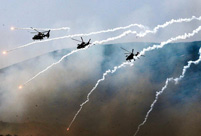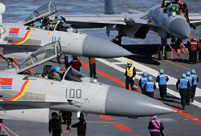

VI. Nuclear Emergency Preparedness Exercises, Drills, Training and Public Communication
China attaches great importance to nuclear emergency preparedness exercises, drills, training and public communication, and continuous efforts have been made to enhance the capabilities of nuclear emergency preparedness organizations at various levels to cope with nuclear accidents, popularize knowledge of nuclear safety and emergency preparedness, create an environment conducive to facilitating nuclear energy development and build society-wide confidence in the country's nuclear energy sector.
Organizing nuclear emergency preparedness exercises. The policies and principles, organization, formats, classifications, frequency, safeguard preparation and implementation procedures for China's nuclear emergency preparedness have been clearly defined in such documents as Regulations on Emergency Measures for Nuclear Accidents at Nuclear Power Plants, Contingency Measures for Unexpected Events, Guideline on Emergency Exercises for Unexpected Events and Regulations on Nuclear Emergency Preparedness Exercises. To cater to the needs of nuclear energy development, national-level nuclear emergency preparedness joint exercises shall be conducted on a regular basis; provincial-level on-site and off-site joint exercises for nuclear emergency preparedness shall be conducted once every two to four years by the relevant provinces (autonomous regions or centrally administered municipalities); operators of nuclear installations shall conduct comprehensive exercises once every two years and special exercises for different purposes every year, with higher frequency for those which have three or more generating units. Prior to the initial fuel loading, an on-site and off-site joint exercise shall be organized by the provincial-level nuclear emergency management organization where the relevant nuclear power plant is located. National-level nuclear emergency joint exercises with the code names "Shendun-2009" and "Shendun-2015" have been conducted and observed by officials and experts from Japan, ROK, France, Pakistan and the IAEA, involving the participation of about 6,000 persons on the two occasions.
Establishing a three-level nuclear emergency preparedness training system. The state nuclear emergency preparedness management organization shall be in charge of training for nation-wide nuclear emergency preparedness management personnel; nuclear emergency preparedness management organizations at the provincial (regional and municipal) level shall be in charge of training for nuclear emergency preparedness personnel within their respective jurisdictions; operators of nuclear installations shall be in charge of providing professional skills training for their own staff in the field of nuclear emergency preparedness. Since the Fukushima accident, China has organized more than 110 training sessions for different levels of nuclear emergency preparedness organizations, attended by a total of 10,000 people. China's nuclear emergency preparedness management personnel and technical professionals have all attended nuclear emergency preparedness trainings of different levels and disciplines.
 |  |
 A foreign girl explains what China should be proud of
A foreign girl explains what China should be proud of Chinese navy's air-cushioned landing craft in pictures
Chinese navy's air-cushioned landing craft in pictures Chinese pole dancing master opens class in Tianjin
Chinese pole dancing master opens class in Tianjin PLA holds joint air-ground military drill
PLA holds joint air-ground military drill Charming female soldiers on Xisha Islands
Charming female soldiers on Xisha Islands Beautiful skiers wear shorts in snow
Beautiful skiers wear shorts in snow Getting close to the crew on China's aircraft carrier
Getting close to the crew on China's aircraft carrier Chinese stewardess celebrate test flight at Nansha Islands
Chinese stewardess celebrate test flight at Nansha Islands Pentagonal Mart becomes the largest vacant building in Shanghai
Pentagonal Mart becomes the largest vacant building in Shanghai Top 20 hottest women in the world in 2014
Top 20 hottest women in the world in 2014 Top 10 hardest languages to learn
Top 10 hardest languages to learn 10 Chinese female stars with most beautiful faces
10 Chinese female stars with most beautiful faces China’s Top 10 Unique Bridges, Highways and Roads
China’s Top 10 Unique Bridges, Highways and Roads Online crusade
Online crusade Choi Sung-kook the king of stickers
Choi Sung-kook the king of stickers PLA art troupes shrink under military restructuring
PLA art troupes shrink under military restructuring Bridging the gap between cultures over the holiday
Bridging the gap between cultures over the holidayDay|Week